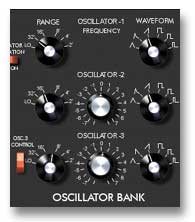
Our coverage of the new Creamware Moog/Prophecy-5 hardware continues with a look at the previous Creamware offering . . .
You thought all hardware was going to be transitioning to software
plug-in? Think again. By using hardware DSP chips, Creamware has been
able to create perfect emulations of original Minimoog and Prophet-5
hardware. The original Minimax and Profit-5 plug-ins (check the plug-in sites for full details) got rave reviews from the likes of Craig Anderton at EQ,
because they (supposedly) recreate the original Moog and Sequential
hardware circuit-for-circuit. Most software emulations use samples and
other trickery. Even other hardware is unlikely to recreate these
original instruments entirely. By using DSP, Creamware was able to
lavishly emulate the physical circuitry of the instruments and keep
processor requirements extremely low (think 400 MHz G3/PC).
Releasing this as standalone hardware is a no-brainer. The Creamware
plugs are great, but they have two major problems. First, there are no
physical knobs for controlling the instruments, and part of the appeal
of things like the original Moog instruments is their physical
interface, not just their sound. Second, when was the last time you
wanted to drag your PCI-based Mac or PC to a gig just to run the
required Creamware SCOPE PCI system?
In other words, just try to beat the US$900/1000 price of the
Minimax/Profit-5 hardware. This is the cheapest Minimoog and Prophecy-5
sound will get. And hardware is the best way to release this beast.